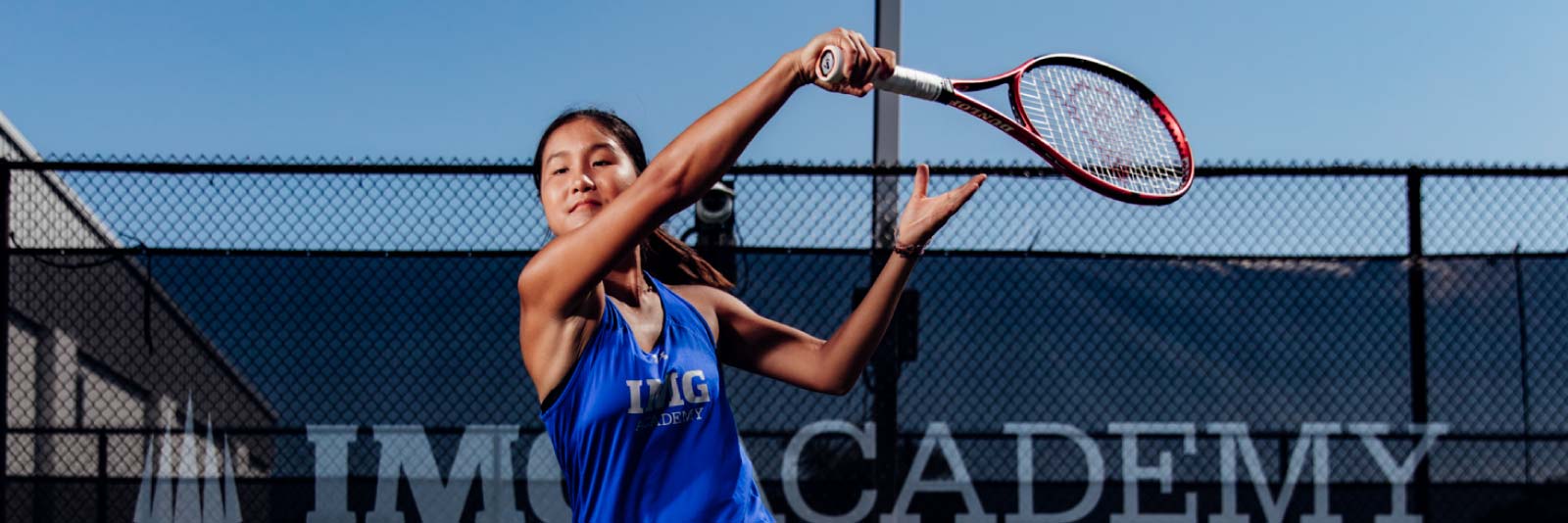There are nearly 11,000 women playing tennis at the collegiate level, but less than 1% of these women are US athletes competing for an NCAA Division 1 program. What’s the reason for such a small percentage? While the limited number of Division 1 programs is one reason, this small percentage is also the result of international recruiting. Collegiate tennis is known for international recruiting at the NCAA level, with a reported 35.4% of women’s NCAA Division 1 tennis players having been recruited internationally in 2017. This is the largest percentage of any NCAA sport.
So, it takes more than just talent for a chance to compete on a college tennis roster. Recruits must put their best foot forward during the recruiting process, with a strong NCSA Recruiting Profile and video, clear and consistent communication with college coaches and high rankings in tournaments. In this section, we look at all aspects of recruiting to help athletes get recruited for college tennis.
Quick Links
How difficult is it to play tennis in college? How good do you have to be?
College coaches prioritize athletes that are top ranked on Tennisrecruiting.net and have a high Universal Tennis Rating. For Division 1 women’s tennis programs, this means the recruit needs to be ranked in the top 50 and labeled a Blue Chip player on Tennisrecruiting.net. For international recruits, it’s important to be ranked at the very top in their country for college coaches to even consider recruiting them. But it’s not all about athletics. Because international recruiting plays such a large role in women’s college tennis recruiting, one way that athletes can stand out is with a strong academic record. When it comes down to making the team and receiving a scholarship, coaches are more likely to recruit a well-rounded athlete over an athlete who is only talented on the court.
Learn more about what college coaches look for in recruits.
How to get recruited for women’s college tennis
When it comes to developing relationships with college coaches, student-athletes need to follow these five steps:
- Pick up the phone: College coaches can’t contact recruits until June 15 of their sophomore year, but this doesn’t mean recruits shouldn’t call coaches and leave a voicemail introducing themselves to let the coach know they are interested in the program. Coaches can answer calls made after June 15 of the recruit’s sophomore year, so be prepared for the coach to ask questions, if they pick up the phone.
- Send introductory emails: Make a goal to connect with one college coach each week. Using a templated introductory email with some personalization, recruits can reach out to express their interest in the tennis program and mention their tournament schedule and high school or club coach contact information.
- Create a letter of recommendation: Select the recruit’s top five programs and ask their high school and club coaches to send a letter of recommendation to college coaches on behalf of the recruit.
- Complete recruiting questionnaire: On the recruit’s NCSA Recruiting Profile, they will find a My Progress tab where they can fill out the recruiting questionnaires for college coaches.
- Utilize social media platforms: Social media platforms like Twitter and YouTube can be used for recruiting purposes, such as posting updates on the recruit’s athletic progress and sharing videos for college coaches to see.
How important is club tennis in getting recruited?
During the offseason, it’s important to compete in tennis tournaments to improve the recruit’s ranking. College coaches rely heavily on an athlete’s tennis ranking when evaluating talent and typically reference Tennisrecruiting.net. Recruits will need to be ranked in the top 50 on Tennisrecruiting.net, if they want to be considered by a Division 1 program and in the top 200 for Division 2 programs.
How do coaches assess a tennis player’s level?
College coaches assess a recruit’s basic shot skills, their tennis ranking and more when evaluating talent. Depending on the division level, college coaches look for specific criteria, such as playing experience, Universal Tennis Rating and Tennisrecruiting.net ranking. While watching matches and highlight video, college coaches will look for a recruit’s understanding of the basic shots, reaction time, agility, endurance and footwork.
What else do college tennis scouts look for in a player?
A recruit can be talented on the court, but if the athlete is not strong academically, college coaches may look them over during the college recruiting process. To be a well-rounded athlete, it’s important for recruits to focus on the NCAA eligibility requirements to ensure they are eligible to compete when the time comes. Beginning freshman year, recruits should research the institution-specific academic standards at their target schools and set academic goals to ensure that they meet both those standards and the NCAA’s eligibility standards.
How do I know what level of competition am I suited for?
To determine what level of competition that a recruit is best suited, start by looking at the Universal Tennis Rating of athletes holding roster spots at the recruit’s target schools. As the official rating system of college tennis, recruits can compare their UTR rating to that of current college roster holders to see how they measure up. When the recruit finds a roster with athletes who have a similar UTR rating, then it’s likely that they are a good fit for that level of competition.
Recruits can also connect with their high school or club coach to help determine their level of competition. As someone who works directly with and provides honest feedback to student-athletes, coaches can be a great resource to help answer this question. With their knowledge of the athlete’s talent and understanding of the different college competition levels, coaches can work with recruits to determine what level of competition for which they are best suited to compete.
How to get ranked in women’s tennis
Recruits must compete in tennis tournaments, like those sponsored by the USTA, in order to be ranked. How do tennis rankings work? Each tournament has a certain number of points associated with it, which is determined by the size of the competition. Athletes must compete in and advance through the tournament in order to earn points. Athletes will be awarded points at the completion, dependent on how far they make it through the tournament.
Tennis rankings are important to college coaches during the recruiting process, but it’s important to keep in mind that these rankings fluctuate from week to week. With athletes competing on a regular basis, the best tennis players typically do not hold a top rank all year round.
Of course, tennis ranking should not be confused with tennis rating, which represents an athlete’s personal playing ability. Universal Tennis Rating (UTR) is the official rating system for college tennis, which is why college coaches consider this rating when evaluating recruits.
Attend national tennis tournaments
To increase exposure and access to college coaches, recruits should attend national tennis tournaments. Available throughout the year, these tournaments attract college coaches from tennis programs across the country. To find the right tennis tournaments to attend, recruits should look for competition that matches their skill level and which tournaments college coaches have attended in the past. Once the recruit has selected a list of tournaments to attend, they should send their competition schedule to college coaches at their target schools. Post-tournament, recruits should send college coaches an email that details their achievements and tournament performance.
Find a list of tennis camps and tournaments near you.
Create a recruiting video with your best highlights
Due to time and budget constraints, a college coach’s first impression of a recruit often comes from watching their recruiting video. Many coaches will begin their recruiting process by evaluating student-athletes’ skillsets in highlight video to build their list of potential recruits. While coaches may come across a recruit’s video while searching recruiting databases, like NCSA, the only way an athlete can guarantee that a coach has received their recruiting video is to send it directly to the coaches in an email.
Keep the video three- to four-minutes long. This allows for roughly 20–30 clips that highlight the athlete’s talent. Include rally and match footage that highlights the recruit’s basic shots, footwork and on-court presence. Start the video with the athlete’s most impressive clips to capture a coach’s attention within the first 30 seconds.
Learn how to create a strong tennis recruiting video.
Research schools and create your target list
To build a target list of colleges that meet the recruit’s needs, we suggest following these guidelines:
- Reach school (5–10 schools): Don’t rule out schools that seem to be out of reach for the recruit because they aren’t athletically or academically qualified, tuition exceeds their budget, etc. Instead, keep these schools on the list because an opportunity could open to pursue this dream.
- Target school (10–20 schools): Target schools are those that the recruit is both athletically and academically qualified to attend that meets the recruit’s expectations. Recruits should aim to have 10–20 schools of these options on their list of potential schools.
- Safety school (3–5 schools): It’s important to include safety schools on a recruit’s list of potential schools. Regardless of the scenario, a recruit should still be accepted and offered a roster spot with one of these programs.
See a list of the best women’s tennis colleges.
Reach out to college coaches on your target list
What’s the best way to connect with a college coach to let them know the recruit is interested in their program? We suggest starting with an introductory email to the college coach that expresses the recruit is interested in playing collegiate tennis, specifically for the coach’s program.
Begin the email with a statement on why the recruit is interested in this program and examples of why they are a good fit for the team. The coach may not be familiar with the recruit yet, so include a link to her recruiting profile where the coach can learn more about her ratings, rankings and watch her recruiting video. Don’t forget to include basic information, including graduation year, high school and club name, GPA, test scores, sport-specific stats and relevant measurables, and the recruit’s phone number and email.
At the end of the email, mention a clear next step, such as scheduling a time to call the coach or inviting them to a tournament or game.
Read more about the different methods to contact college coaches.
How your high school coach can help you get recruited
The college recruiting process can be complicated, but experienced high school and club coaches are a great resource that recruits rely on to help them through the process. Here are three ways a recruit’s coach can support them during the recruiting process.
- Create connections: Many high school and club coaches have developed strong relationships with college coaches over the span of their coaching careers. As a result, high school and club coaches can introduce recruits to college coaches and help start their relationship building.
- Provide feedback: It’s not always clear what division level a recruit is best suited to play. Because high school and club coaches watch the recruit compete and practice on a regular basis, they can use their knowledge of the athlete’s talent to provide honest feedback and identify a realistic division level for the recruit.
- Recommendations: The NCAA allows college coaches to contact high school or club coaches for general feedback on a recruit. Coaches can ask questions around the recruit’s character, attitude, work ethic and talent. The answers that coaches receive to these questions can largely impact their recruitment. Recruits should give their high school and club coach a heads-up if they are being recruited by a college program, so that they may receive a call from the college coach looking for general feedback.

